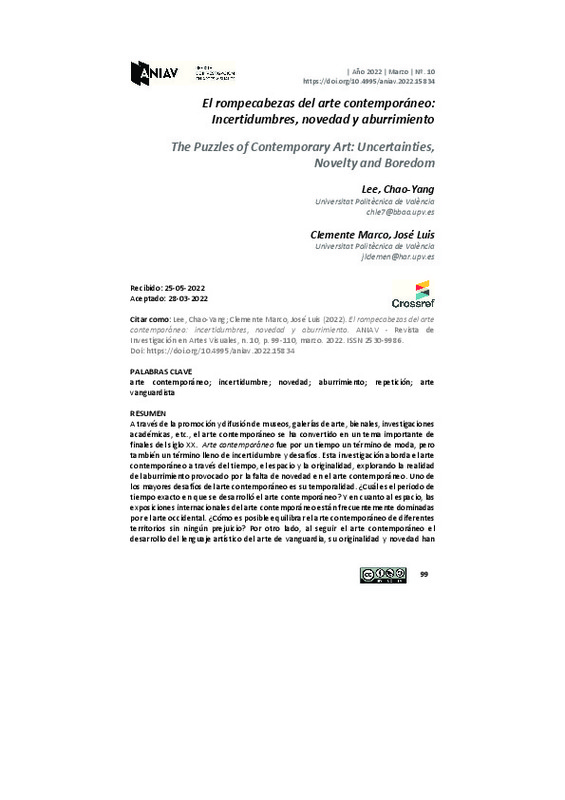|
Resumen:
|
[EN] Through the promotion and spread of museums, art galleries, biennials, academic research, etc., contemporary art has become an important subject since the late 20th century. Contemporary art was once a fashionable ...[+]
[EN] Through the promotion and spread of museums, art galleries, biennials, academic research, etc., contemporary art has become an important subject since the late 20th century. Contemporary art was once a fashionable term, but it is also a term full of uncertainties and challenges. This investigation will discuss contemporary art through time, space and originality, and will explore the reality of boredom caused by contemporary art s lack of newness. One of the biggest challenges of contemporary art is its temporality: determining the exact timeline of contemporary art is a perpetual topic of debate. Moreover, in terms of space, international contemporary art exhibitions are frequently dominated by Western art. How, then, is it possible to increase representation of the contemporary art from different territory without any prejudice? On the other hand, as contemporary art has followed the development of the artistic language of avant-garde art, its originality and novelty have been widely questioned. Its characteristic of repetition causes a reduction in novelty, ultimately bringing its viewers into boredom. But is this really the fate of contemporary art? Structuralists and deconstructionists explore the relationship between contemporary art and avant-garde art from different perspectives, dismantling the power and originality of the latter. However, is this type of analysis really a reliable and meaningful way to interpret contemporary art? Or does it take contemporary art further into nihility and boredom? All of these issues will be explored in this investigation.
[-]
[ES] A través de la promoción y difusión de museos, galerías de arte, bienales, investigaciones académicas, etc., el arte contemporáneo se ha convertido en un tema importante de finales del siglo XX. Arte contemporáneo ...[+]
[ES] A través de la promoción y difusión de museos, galerías de arte, bienales, investigaciones académicas, etc., el arte contemporáneo se ha convertido en un tema importante de finales del siglo XX. Arte contemporáneo fue por un tiempo un término de moda, pero también un término lleno de incertidumbre y desafíos. Esta investigación aborda el arte contemporáneo a través del tiempo, el espacio y la originalidad, explorando la realidad del aburrimiento provocado por la falta de novedad en el arte contemporáneo. Uno de los mayores desafíos del arte contemporáneo es su temporalidad. ¿Cuál es el periodo de tiempo exacto en que se desarrolló el arte contemporáneo? Y en cuanto al espacio, las exposiciones internacionales del arte contemporáneo están frecuentemente dominadas por el arte occidental. ¿Cómo es posible equilibrar el arte contemporáneo de diferentes territorios sin ningún prejuicio? Por otro lado, al seguir el arte contemporáneo el desarrollo del lenguaje artístico del arte de vanguardia, su originalidad y novedad han sido ampliamente cuestionados. Su característica de repetición provoca la reducción de la novedad, y finalmente lleva al aburrimiento a sus espectadores. Pero, ¿es este realmente el destino del arte contemporáneo? Estructuralistas y deconstruccionistas exploran la relación entre el arte contemporáneo y el arte de vanguardia desde diferentes perspectivas, desmantelando el poder y la originalidad del arte de vanguardia. Sin embargo, ¿este tipo de análisis es realmente una forma fiable y significativa de interpretar el arte contemporáneo? ¿O es llevar el arte contemporáneo a la nihilidad y el aburrimiento? Todos estos son los temas que exploramos en esta investigación.
[-]
|








